#parker solar probe
Text
NASA's sun-touching Parker Solar probe has flown close enough to our star to spot the fine details of the solar wind — including its origin, "coronal holes" in the sun's atmosphere.
Armed with this information, scientists may now be able to better predict solar storms that can supercharge auroras over our planet but can also disrupt communication and power infrastructure and pose a threat to satellites, spacecraft and even astronauts.
The Parker Solar Probe tracked the solar wind — a stream of charged particles flowing continuously from the sun — back to where it is generated, a new study reports. This allowed researchers to see characteristics of the solar wind that are lost as it exits the sun's outer atmosphere, or corona, and before it reaches Earth as a relatively uniform stream.
The spacecraft saw that the streams of high-energy particles that make up the solar wind match so-called "supergranulation flows" within coronal holes. This discovery pointed to these regions as the source of the "fast" solar wind, which is seen over the poles of the sun and can reach speeds as great as 1.7 million mph (2.7 million kph), around 1,000 times faster than the top speed of a jet fighter.
Continue Reading
65 notes
·
View notes
Text

Kiss the Sun
Parker Solar Probe giving me so many thoughts.....
#THIS HAS BEEN IN MY DRAFTS SINCE APRIL WAAAAGHH-#Not too happy with it anymore but eh whatever can't help the lack of painting skill ksjsjsjjdsj#Enjoy the pasta sun#digital art#fanart#digital painting#spacecraft#parker solar probe
50 notes
·
View notes
Text

In my micolash era again. Look at this freakazoid (Parker Solar Probe)
32 notes
·
View notes
Text
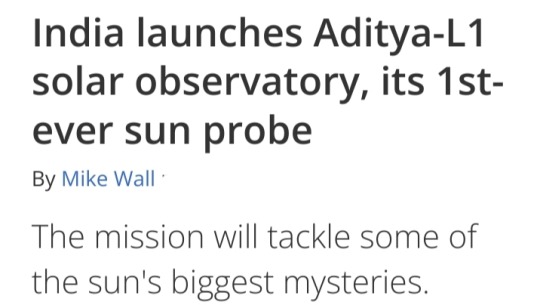
2 September 2022
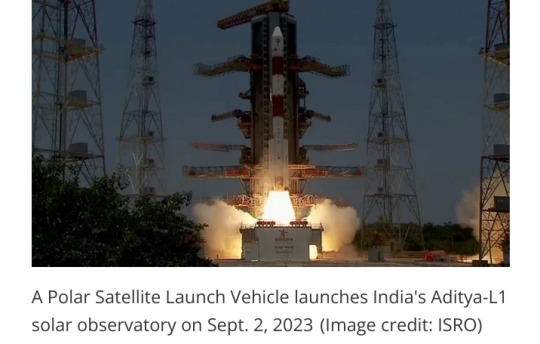
Fresh off its success at the moon, India is now headed for the sun.
The nation launched its first-ever solar observatory today (Sept. 2), sending the Aditya-L1 probe skyward atop a Polar Satellite Launch Vehicle (PSLV) from Satish Dhawan Space Centre at 2:20 a.m. EDT (0620 GMT; 11:50 a.m. local India time).
The PSLV deployed Aditya-L1 into low Earth orbit (LEO) as planned about 63 minutes after liftoff, sparking applause and high fives in mission control.
"Congratulations, India, and congratulations, ISRO [the Indian Space Research Organisation]," Jitendra Singh, India's Minister of State for Science and Technology, said shortly after deployment on ISRO's launch webcast.
"While the whole world watched this with bated breath, it is indeed a sunshine moment for India," Singh added.
The successful launch followed on the heels of another big milestone for India: On August 23, its Chandrayaan-3 mission became the first to land softly near the moon's south pole.
Chandrayaan-3's lander-rover duo are expected to conk out in a week or so, when the harsh lunar night falls at their touchdown site. But Aditya-L1's long journey has just begun.
A long road to a good sun-viewing spot
Aditya-L1 won't stay in LEO forever:
After a series of checkouts, it will use its onboard propulsion system to head toward Earth-sun Lagrange Point 1 (L1), a gravitationally stable spot about 1 million miles (1.5 million kilometers) from our planet in the direction of the sun.
That destination explains the latter part of the mission's name. And the first part is simple enough: "Aditya" translates to "sun" in Sanskrit.
The 3,260-pound (1,480 kilograms) observatory will arrive at L1 about four months from now, if all goes according to plan.
But the long trek will be worth it, according to the ISRO.
"A satellite placed in the halo orbit around the L1 point has the major advantage of continuously viewing the sun without any occultation/eclipses," ISRO officials wrote in an Aditya-L1 mission description.
"This will provide a greater advantage of observing the solar activities and its effect on space weather in real time."
Indeed, another sun-studying spacecraft is already at L1 — the Solar and Heliospheric Observatory (SOHO), a joint NASA-European Space Agency mission that launched in December 1995.
(Several other spacecraft, including NASA's James Webb Space Telescope, are at Earth-sun Lagrange Point 2, which is a million miles from Earth, in the direction away from the sun.)

Solar flares, the coronal heating mystery and more
Once it's settled in at L1, the solar probe will use four three science instruments to study the particles and magnetic fields in its immediate surroundings and four others to scrutinize the sun's surface (known as the photosphere) and its atmosphere.
This work will help scientists better understand solar activity, including the dynamics of solar flares and coronal mass ejections (CMEs), ISRO officials say.
Flares are powerful flashes of high-energy radiation, and CMEs are huge eruptions of solar plasma.
Both types of outburst can affect us here on Earth. Intense CMEs that hit our planet, for example, trigger geomagnetic storms that can disrupt satellite navigation and power grids.
(As a side benefit, such storms also supercharge the gorgeous light shows known as auroras.)
Aditya-L1 will also tackle the "coronal heating problem," one of the biggest mysteries in heliophysics.
The corona — the sun's wispy outer atmosphere — is incredibly hot, reaching temperatures around 2 million degrees Fahrenheit (1.1 million degrees Celsius), according to NASA.
That's about 200 times hotter than the solar surface, which is "only" 10,000 degrees F (5,500 degrees C) or so.
It's still unclear what is responsible for this startling and counterintuitive discrepancy.
(Why would it be hotter away from the sun's core, where the energy-producing nuclear fusion reactions are occurring?)
Aditya-L1 has other science goals as well. For instance, the mission also aims to more fully flesh out the solar wind, the stream of charged particles flowing constantly from the sun, ISRO officials said.
Aditya-L1 will measure the composition of the solar wind and attempt to determine how it is accelerated.
And Aditya-L1 will do all this work on the cheap:
The mission's price tag is about 3.8 billion rupees, or $46 million US at current exchange rates.
That's in the same ballpark as Chandrayaan-3
India's first successful moon-landing mission costs about 6.15 billion rupees, or $74 million US.
For comparison, NASA's most recent big-ticket sun mission, the record-setting Parker Solar Probe, costs roughly $1.5 billion.
This disparity should not be viewed as an indictment of NASA, however; labor costs are much higher in the United States than in India, among other differences between the two nations' economies.
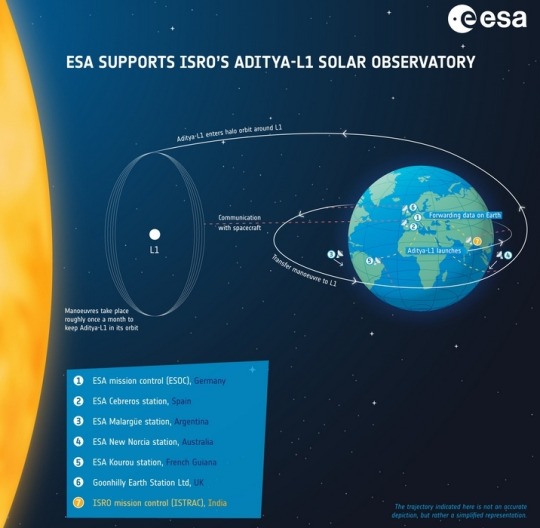
Aditya-L1 is a coronagraphy spacecraft to study the solar atmosphere, designed and developed by the Indian Space Research Organisation (ISRO) and various other Indian research institutes.
#India#Aditya-L1#Polar Satellite Launch Vehicle (PSLV)#Satish Dhawan Space Centre#low Earth orbit (LEO)#sun#Indian Space Research Organisation#Chandrayaan-3#Earth-sun Lagrange Point 1 (L1)#Solar and Heliospheric Observatory (SOHO)#solar flares#coronal mass ejections (CMEs)#coronal heating problem#heliophysics#solar wind#Parker Solar Probe#NASA#solar observatory#solar atmosphere
12 notes
·
View notes
Text
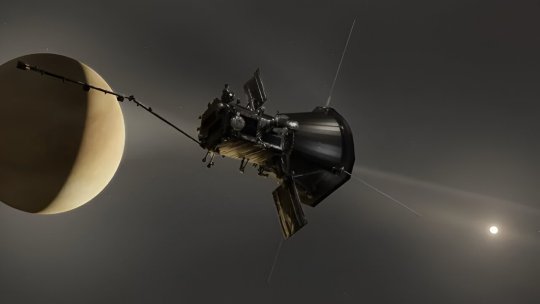
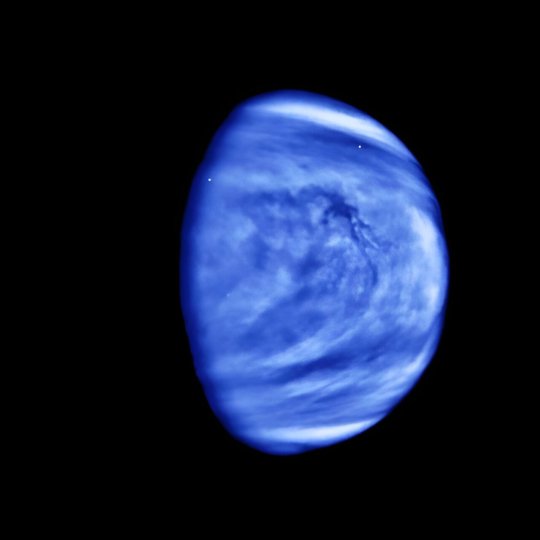
Does lightning strike on Venus? Maybe not, study suggests
Venus may be a (slightly) gentler place than some scientists give it credit for.
In new research, space physicists at CU Boulder have jumped into a surprisingly long-running debate in solar system science: Does lightning strike on the second planet from the sun?
The team's results add strong new evidence suggesting that, no, you probably wouldn't see bolts of lightning flashing from Venus' thick, acidic clouds—or, at least, not very often.
"There's been debate about lightning on Venus for close to 40 years," said Harriet George, lead author of the new study and a postdoctoral researcher at the Laboratory for Atmospheric and Space Physics (LASP). "Hopefully, with our newly available data, we can help to reconcile that debate."
She and her team published their findings in the journal Geophysical Research Letters.
The research takes a deep dive into one of the most mysterious, and inhospitable, bodies in the solar system. Venus is about the same size as Earth, but its dense, carbon dioxide-rich atmosphere has led to a runaway greenhouse effect. Anyone standing on the ground would face searing temperatures of 900 degrees Fahrenheit and crushing atmospheric pressures. No spacecraft has ever survived for more than a few hours on the planet's surface.
To explore this extreme world, the researchers turned to a scientific tool that wasn't designed to study Venus at all: NASA's Parker Solar Probe, which launched in 2018 as part of a 7-year mission to investigate the physics of the sun's corona, or outermost atmosphere, and the solar wind. Parker Solar Probe was designed, built and is now operated by the Johns Hopkins Applied Physics Laboratory, which leads the mission for NASA.
In February 2021, the spacecraft swooped around Venus at a distance of roughly 1,500 miles. In the process, its instruments picked up dozens of what scientists call "whistler waves"—pulses of energy that, on Earth at least, can be kicked off by bolts of lightning. The team's data showed that Venus' whistler waves may not actually originate from lightning, but rather from disturbances in the weak magnetic fields that envelop the planet.
The results agree with a 2021 study, which failed to detect radio waves generated by lightning strikes coming from Venus. The research was led by Marc Pulupa of the University of California, Berkeley.
David Malaspina, a co-author of the new study, said the findings show just how little humans know about one of our nearest neighbors.
"It's very rare that new scientific instruments make it to Venus," said Malaspina, assistant professor at LASP and the Department of Astrophysical and Planetary Sciences. "We don't get a lot of chances to do this kind of interesting research."
Dark and stormy nights
Much of the debate around Venus and lightning dates back to 1978 when a NASA spacecraft called Pioneer Venus entered into orbit around Earth's hotter, angrier twin. Almost immediately, the spacecraft began picking up the signals of whistler waves hundreds of miles above the planet's surface.
For many scientists, these signals were reminiscent of a familiar phenomenon from Earth: lightning.
George explained that, on Earth, whistler waves are often—but not always—created by lightning. Lightning strikes, she said, can jostle electrons in the planet's atmosphere, which then launch waves that spiral out into space. These waves create whistling tones that early radio operators on Earth could hear using headphones, hence the name "whistlers."
If Venus' whistler waves have a similar origin, then the planet might be a monster of lightning, experiencing roughly seven times more strikes than Earth. Scientists have also spotted lightning on Saturn and Jupiter.
"Some scientists saw those signatures and said, "That could be lightning,'" George said. "Others have said, "Actually, it could be something else." There's been back and forth about it for decades since."
A brush with Venus
Parker Solar Probe could offer scientists an opportunity to resolve the debate for good.
George said that the spacecraft will skim by Venus seven times during its mission, using these flybys to draw closer and closer to the sun. In 2021, during its fourth such maneuver, the probe got remarkably near to the planet—passing into the shadow cast behind Venus, a prime spot to go looking for whistler waves.
To find those signals, George, Malaspina and their colleagues used Parker Solar Probe's FIELDS Experiment, a set of electric and magnetic field sensors that stick out from the spacecraft. (A team at CU Boulder and LASP designed and built the Digital Fields Board, which analyzes signals from the FIELDS sensors).
When the researchers analyzed a set of those whistlers, however, they noticed something surprising: Venus' whistler waves were headed the wrong way. They seemed to be moving down toward the planet, not out into space like you'd expect from a lightning storm.
"They were heading backward from what everybody had been imagining for the last 40 years," Malaspina said.
What is causing these backward whistlers isn't clear. George and Malaspina suspect that they may emerge from a phenomenon called magnetic reconnection—in which the twisting magnetic field lines that surround Venus come apart then snap back together with explosive results.
For now, the researchers say they need to analyze more whistlers to completely rule out lightning as a cause. They'll get their next chance in November 2024 when the Parker Solar Probe makes its final pass by Venus, dropping down to less than 250 miles above the surface—brushing the top of the planet's "soupy" atmosphere, Malaspina said.
"Parker Solar Probe is a very capable spacecraft. Everywhere it goes, it finds something new."
TOP IMAGE....Artist's depiction of the Parker Solar Probe flying past Venus. Credit: NASA/Johns Hopkins APL
LOWER IMAGE....An image of Venus taken by NASA's Galileo spacecraft in 1990, shown in false color to highlight the sulfuric acid clouds swirling above the planet's surface. Credit: NASA/JPL
8 notes
·
View notes
Text
youtube
I could maybe rant about and rewatch this for the next 150,000,000 lifetimes. A few highlights:
• Though Jupiter is the obvious choice for gravity assists to increase or decrease orbital velocity, Venus was used instead for its solar proximity, adding hundreds of hours of effective work time for the Parker mission.
• The need to collapse and protect the onboard instrumentation meant that the solar panels, among all the rest, had to be as small as possible: smaller than would be possible with a Jovian gravity assist, further justifying the Venusian path.
• Copper and aluminum, normal electrical wire conductors, would melt in the heat of the sun, and were replaced with a very heat resistant Neodymium-Hafnium alloy. The typically plastic jacketing/insulator was likewise replaced with synthetic sapphire.
• To stress test many of the instruments onboard, a massive "solar furnace"– a huge array of mirrors focused at a giant, parabolic mirror, which directs light into one spot– was used. To test the functionality of certain imaging and particle sensors, 6 high powered IMAX projectors were used. Certain instruments were proved more efficient under such circumstances, as the heat further decontaminated the sensors.
• Though, outside of the images, most of the discoveries by the Parker probe tend more mathematical than charismatic, as far as space facts go, they are still uniquely informative, band may help with the development of terrestrial fusion reactors.
#solar power#the sun#space#astronomy#parker solar probe#fusion power#science#THIS IS SO COOL#to touch the face of God#Youtube
2 notes
·
View notes
Text
Oh my god the solar probe was in 2018???
#the passage of time…#yikes dude#parker solar probe#my lovely grandmother who knows I like space recorded a program for me!#which is nice cuz I haven’t really heard anything about it
3 notes
·
View notes
Text
"At top speed, NASA's Parker Solar Probe could zoom from NYC to LA in just 20 seconds."
"The newest milestone comes thanks to a previous gravity-assist flyby from Venus, and occurred on September 27 at the midway point of the probe’s 17th “solar encounter” that lasted until October 3. As ScienceAlert also noted on October 9, the Parker Solar Probe’s speed would hypothetically allow an airplane to circumnavigate Earth about 15 times per hour, or skip between New York City and Los Angeles in barely 20 seconds. Not that any passengers could survive such a journey, but it remains impressive."
1 note
·
View note
Text
Is there lightning on Venus?
Scientists have debated this question for decades. With its thick, cloudy atmosphere, we might expect Venus to have lightning, just as Earth does. Many artist’s concepts have depicted mighty lightning bolts crashing down under Venus’ heavy clouds. But now, a new study from researchers at the University of Colorado Boulder casts doubt on the idea of Venus lightning. The findings were announced on October 2, 2023. Interestingly, the insights come from data collected not by an earthly telescope or a Venus spacecraft, but by NASA’s Parker Solar Probe, first spacecraft to touch the sun. The new results suggest lightning is rare on Venus, if it happens at all.
0 notes
Text
Beeindruckende Bilder der #Parker Solar Probe während einer gewaltigen Sonneneruption
0 notes
Text
Hit 'ehm hard; hit 'ehm fast; hit 'ehm with the Parker Solar Probe
1 note
·
View note
Text
Sonda solar Parker volaba hacia el viento solar y encontró su fuente
La Sonda Solar Parker (PSP) de la NASA ha volado lo suficientemente cerca del sol para detectar la fina estructura del viento solar cerca de donde se genera en la superficie del sol, revelando detalles que se pierden cuando el viento sale de la corona como una explosión uniforme de partículas cargadas.
Es como ver chorros de agua que emanan de un cabezal de ducha a través del chorro de agua que…

View On WordPress
0 notes
Photo

Direct First Parker Solar Probe Observation of the Interaction of Two Successive Interplanetary Coronal Mass Ejections in 2020 November
We investigate the effects of the evolutionary processes in the internal magnetic structure of two interplanetary coronal mass ejections (ICMEs) detected in situ between 2020 November 29 and December 1 by the Parker Solar Probe (PSP). The sources of the ICMEs were observed remotely at the Sun in EUV and subsequently tracked to their coronal counterparts in white light. This period is of particular interest to the community as it has been identified as the first widespread solar energetic particle event of solar cycle 25. The distribution of various solar and heliospheric-dedicated spacecraft throughout the inner heliosphere during PSP observations of these large-scale magnetic structures enables a comprehensive analysis of the internal evolution and topology of such structures. By assembling different models and techniques, we identify the signatures of interaction between the two consecutive ICMEs and the implications for their internal structure. We use multispacecraft observations in combination with a remote-sensing forward modeling technique, numerical propagation models, and in situ reconstruction techniques. The outcome, from the full reconciliations, demonstrates that the two coronal mass ejections (CMEs) are interacting in the vicinity of the PSP. Thus, we identify the in situ observations based on the physical processes that are associated with the interaction and collision of both CMEs. We also expand the flux rope modeling and in situ reconstruction technique to incorporate the aging and expansion effects in a distorted internal magnetic structure and explore the implications of both effects in the magnetic configuration of the ICMEs.
0 notes
Text

Parker probe observes powerful coronal mass ejection 'vacuum up' interplanetary dust
NASA's Parker Solar Probe soared gracefully through one of the most powerful coronal mass ejections (CMEs) ever recorded—not only an impressive feat of engineering, but a huge boon for the scientific community. Parker's journey through the CME is helping to prove a 20-year-old theory about the interaction of CMEs with interplanetary dust, with implications for space weather predictions. The results were recently published in The Astrophysical Journal.
A 2003 paper theorized that CMEs may interact with interplanetary dust in orbit around our star and even carry the dust outward. CMEs are immense eruptions from the sun's outer atmosphere, or corona, that help drive space weather, which can endanger satellites, disrupt communications and navigation technologies, and even knock out power grids on Earth. Learning more about how these events interact with interplanetary dust could help scientists better predict how quickly CMEs could travel from the sun to Earth, forecasting when the planet could see their impact.
Parker has now observed this phenomenon for the first time.
"These interactions between CMEs and dust were theorized two decades ago, but had not been observed until Parker Solar Probe viewed a CME act like a vacuum cleaner, clearing the dust out of its path," said Guillermo Stenborg, an astrophysicist at the Johns Hopkins Applied Physics Laboratory (APL) in Laurel, Maryland, and lead author on the paper. APL built and operates the spacecraft.
This dust is made up of tiny particles from asteroids, comets, and even planets, and is present throughout the solar system. A type of faint glow called zodiacal light, sometimes visible before sunrise or after sunset, is one manifestation of the cloud of interplanetary dust.
The CME displaced the dust all the way out to about 6 million miles from the sun—about one-sixth of the distance between the sun and Mercury—but it was replenished almost immediately by the interplanetary dust floating through the solar system.
In-situ observations from Parker were critical to this discovery, because characterizing dust dynamics in the wake of CMEs is challenging from a distance. According to the researchers, Parker's observations could also provide insight into related phenomena lower down in the corona, such as coronal dimming caused by low-density areas in the corona that often appear after CMEs erupt.
Scientists observed the interaction between the CME and dust as decreased brightness in images from Parker's Wide-field Imager for Solar Probe (WISPR) camera. This is because interplanetary dust reflects light, amplifying brightness where the dust is present.
To locate this occurrence of decreased brightness, the team had to compute the average background brightness of WISPR images across several similar orbits—sifting out normal brightness variations that occur due to solar streamers and other changes in the solar corona.
"Parker has orbited the sun four times at the same distance, allowing us to compare data from one pass to the next very well," Stenborg said. "By removing brightness variations due to coronal shifts and other phenomena, we were able to isolate the variations caused by dust depletion."
Because scientists have only observed this effect in connection with the Sept. 5 event, Stenborg and the team theorize that dust depletion may only occur with the most powerful CMEs.
Nevertheless, studying the physics behind this interaction may have implications for space weather prediction. Scientists are just starting to understand that interplanetary dust affects the shape and speed of a CME. But more studies are needed to understand these interactions better.
Parker completed its sixth Venus flyby, using the planet's gravity to sling itself even closer to the sun for its next five close approaches. This occurs as the sun itself is approaching solar maximum, the period in the sun's 11-year cycle when sunspots and solar activity are most abundant. As the sun's activity increases, scientists hope to have the opportunity to see more of these rare phenomena and explore how they might affect our Earth environment and the interplanetary medium.
IMAGE....SDO/AIA 193 Å images showing the CHs considered for analysis at the time of the central meridian crossing. The boundaries of each CH (polygons delimited by the dashed cyan lines) were obtained by the SPoCA algorithm. The corresponding centroids are depicted with the star symbol. Credit: The Astrophysical Journal (2023). DOI: 10.3847/1538-4357/acd2cf
5 notes
·
View notes
Text
anyways i'm still on that space probe wave. i want to make,,,, space probe-coded ocs or just even designs--
#im using words#i just found out about the Parker Solar Probe TODAY#A PROBE. WITHIN THE ATMOSPHERE OF THE SUN
4 notes
·
View notes
Text
WHY WERE NONE OF Y’ALL GOING TO TELL ME THE FASTEST MANMADE OBJECT ISN’T A MANHOLE COVER ANYMORE AND HASN’T BEEN FOR OVER TWO YEARS
2 notes
·
View notes